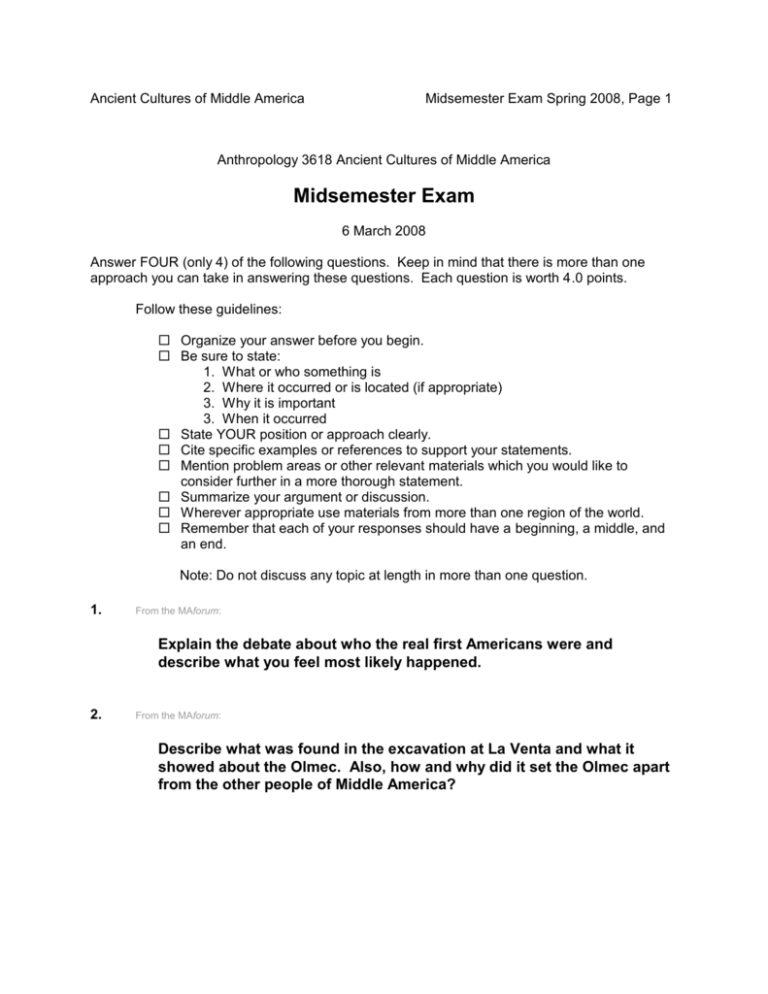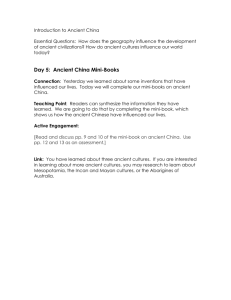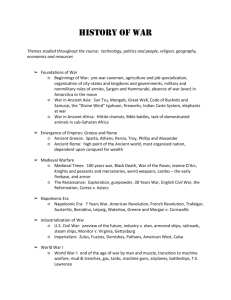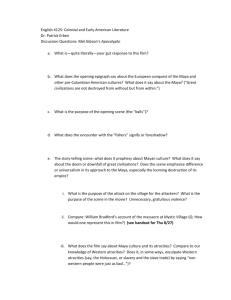
Ancient Cultures of Middle America
Midsemester Exam Spring 2008, Page 1
Anthropology 3618 Ancient Cultures of Middle America
Midsemester Exam
6 March 2008
Answer FOUR (only 4) of the following questions. Keep in mind that there is more than one
approach you can take in answering these questions. Each question is worth 4.0 points.
Follow these guidelines:
Organize your answer before you begin.
Be sure to state:
1. What or who something is
2. Where it occurred or is located (if appropriate)
3. Why it is important
3. When it occurred
State YOUR position or approach clearly.
Cite specific examples or references to support your statements.
Mention problem areas or other relevant materials which you would like to
consider further in a more thorough statement.
Summarize your argument or discussion.
Wherever appropriate use materials from more than one region of the world.
Remember that each of your responses should have a beginning, a middle, and
an end.
Note: Do not discuss any topic at length in more than one question.
1.
From the MAforum:
Explain the debate about who the real first Americans were and
describe what you feel most likely happened.
2.
From the MAforum:
Describe what was found in the excavation at La Venta and what it
showed about the Olmec. Also, how and why did it set the Olmec apart
from the other people of Middle America?
Ancient Cultures of Middle America
3.
Midsemester Exam Spring 2008, Page 2
From the MAforum:
According to our readings in the book The Maya what kind of political
social system did the ancient Maya live in? How were their lineages
ranked and how did this affect the social system? Explain whether, and
how, this differs from our society, and whether this society mimics ours
or any other current political social structure.
4.
From the MAforum:
Explain the existence of the complex number systems and calendars of
the ancient Mayans, and why it is a significant discovery.
5.
From the MAforum:
Explain what significances water must have had for the Mayan people.
6.
From the MAforum:
Explain the role of the jaguar to the Aztecs, and its importance to the
transition to a new world.
7.
From the MAforum:
Explain the journey of the Aztecs before they arrived at Lake Texcoco,
including the hardships they faced and how their religious beliefs
affected their attitudes toward life and death once they reached their
destination.
8.
Discuss the Lithic ("Early Hunters") and Archaic ("Incipient
Agriculture") periods as they were manifested in the Mesoamerican
culture area. You may include in your answer comparisons with the
early cultures of North America.
9.
Explain why underwater archeology is so important to the study of
ancient Middle America. Be sure to include specific examples in your
answer.
Ancient Cultures of Middle America
Midsemester Exam Spring 2008, Page 3
10.
What is ethnographic analogy? How is it used in the study of Ancient
Mesoamerica? Be sure to include specific examples in your answer.
11.
Discuss the basic temporal terms and concepts used in American
Archaeology, including specific examples for each one and the reasons
why you think each term may or may not be useful in understanding
“process.”
12.
Optional Take-Home Question:
NOTE: Essentially you may make up ONE question total. You may either do that as a take-home and
bring it to class with you, or you may do that in class the day of the exam. If you elect to do the
optional take-home exam and bring it with you to class, then you must choose three (3) additional of
the remaining questions presented on the actual exam, as they are presented on the exam.
If you do not like these questions, make up and answer a question of your own
choice relating to a topic which you have not considered in your other answers.
Answers should contain specific information supporting your position. Both your
question and your answer will be evaluated. If you like these questions but simply
prefer to make one of your own, go ahead.
If you elect to make up and answer a question, you may prepare your question and
answer in advance and bring them with you to the exam. If you prepare your
question and answer in advance you only need to answer three (3) midterm exam
questions in class.
13.
On Current Affairs:
Last week MSNBC and other news media reported that “Ancient Maya temples
[were] not just for royalty: Different factions, even commoners, may have built
structures” (Wednesday, 27 February 2008). The full text of the MSNBC article is
attached.
Assuming the report of this new discovery is accurate, what impact will
it likely have on the study and interpretation of Ancient Middle America?
Why?
Ancient Cultures of Middle America
Midsemester Exam Spring 2008, Page 4
University of Illinois at Urbana-Champaign
<http://www.eurekalert.org/multimedia/pub/7034.php?from=109760>
Ancient Maya temples not just for royalty
Different factions, even commoners, may have built structures
By Charles Q. Choi
LiveScience
updated 2:12 p.m. CT, Wed., Feb. 27, 2008
It was long thought that the ancient stone pyramid temples of the Maya were built by their
royalty.
Now it turns out any number of different factions among the Maya — nobles, priests and maybe
even commoners — may have built temples, scientists now suggest.
The fact that different groups had the will and the power to build temples suggests "the Maya
could choose which temples to worship in and support; they had a voice in who succeeded
politically," said researcher Lisa Lucero, an archaeologist at the University of Illinois at UrbanaChampaign.
The first temples of the Maya arose more than 2,000 years ago. Their word for these stone
pyramids was the same as their word for mountain, and the massive stepped temples at times
reached more than 200 feet high.
Ancient Cultures of Middle America
Midsemester Exam Spring 2008, Page 5
"Human sacrifice did occur at temples, but only rarely, unlike the Aztec, who sacrificed daily in
the belief the sun would not rise otherwise," Lucero said, speaking of the Maya during the
Classic Period, from 250 A.D. to 900 A.D. "Only a few powerful Maya kings performed human
sacrifice, and they did it to kill rulers from elsewhere. And they didn't do it to bring, say, better
weather, but to highlight 'me, me, me.'"
Lucero and her colleagues investigated temples in Yalbac, a Maya center in the steaming jungles
of central Belize. "We were surrounded by howler monkeys, toucans, spider monkeys, orchids,
spiders, scorpions and snakes," she recalled. "Killer bees are now in the area, and a hive can just
appear one day. I ran immediately when I saw one, and I was still stung four times."
Mysteriously, there are six temples all close together in Yalbac, ranging from 25 to 50 feet high.
"Why did they need six? Did they have one for different days of the week? Different gods?
Different seasons?" Lucero wondered.
Upon investigating each temple — which date from the Late Classic period of Maya history,
about 550 to 850 A.D. — she noted their construction and materials could differ from each other
quite significantly. Two higher quality temples used larger outermost stones and more mortar to
fill the insides of the pyramids. "These essentially cost more money, and may have been royal,"
Lucero said. "But the other temples may not have been built by royalty at all."
Each temple might have served a different god, such as the rain god Chak, or the sun god or
maize god. The building of each temple might also serve as a record of ancient power struggles.
"When a new ruler comes to power, they might build their own place, or if the rulers did not
predict the best time to plant crops, others might suggest, 'Come to my temple, the ruler has
clearly failed,'" Lucero said.
Looters had carved nine trenches into the Yalbac site in their pursuit of ancient treasure. This
summer Lucero and her colleagues hope to see "if the looters missed caches — artifacts
consisting of shell, jade, ceramics, lithics, et cetera — that may provide clues as to temple
function and purpose," she said.
Lucero and her colleagues detailed their findings in the latest issue of the journal Latin American
Antiquity.
© 2008 LiveScience.com. All rights reserved.
URL: http://www.msnbc.msn.com/id/23374053/
© 2008 MSNBC.com
Ancient Cultures of Middle America
Midsemester Exam Spring 2008, Page 6
From the Texas A&M Anthropology in the News report of 28 February 2008:
Royals Weren't Only Builders Of Maya Temples, Archaeologist Finds Science Daily (2/25/08)
Royals Weren't Only Builders of Maya Temples, Archaeologist Finds EurekAlert (2/25/08)
Ancient Mayans: Temples for Everyone! LiveScience (2/27/08)
Ancient Maya Temples Not Just for Royalty MSNBC (2/27/08)
The Pyramid of Kukulkan, a temple built to honor the feathered serpent god, still stands in Chichén Itzá.
MSNBC (2/27/08)
Please return this exam
with your blue book.









